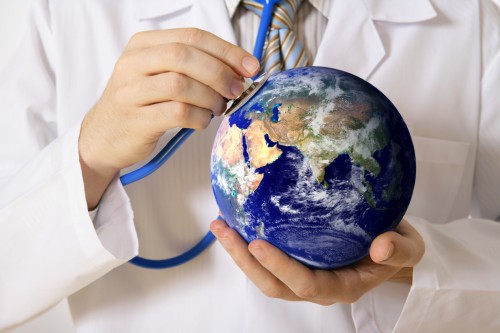The climate of American medicine
Originally posted on July 25, 2019 by Dr. Sam Stea in the Williamsport Sun-Gazette.
 Let’s just get this fact out of the way at the outset: Climate change is real.
Let’s just get this fact out of the way at the outset: Climate change is real.
Climate science is real.
When 97 percent of all scientists dedicated to the subject agree on something to a greater or lesser degree? It is real, plain and simple.
The potential for its worst-case scenarios are real, and the potential outcomes of those scenarios are dire for health care across this country and around the world. Climate scientists continue to shout from the mountaintops, warning the public of melting icecaps, flooded cities, shortages of food and water, extreme weather events, the inevitable migrating swath of climate refugees by the millions, and the health and disease epidemics that are certain to follow.
Slow as it has been, the American public’s perception of climate change seems to be shifting, from non-urgency toward seriousness, from denial toward a general acceptance. Much credit is due to climate scientists who continue to shout louder and louder with each new study. With each new clarion call, there is a growing consensus that supports the claim of the monumental catastrophe and global health crisis that potentially lies ahead.
And if not within most of our lifetimes, then certainly within the lifetimes of our children.
But there is a notable faction missing from these united voices. One of the most powerful voices in the room has remained mostly silent to the point of becoming inconsequential. I speak of the near entirety of the medical profession and American medical community. Precious few physicians and organizations in America are playing an active role in what may well become the greatest threat to human health in recorded history.
As a physician, a nephrologist, spending most of my working energy preventing kidney disease and administering dialysis, I am hard-pressed to explain this disheartening disconnect between emerging health reality and the continued silence of those who swear an oath to “Do No Harm”.
It haunts me, day to day, in casual discussion with my peers, during teaching rounds and in staff meetings. It is as if the very concept of climate change has yet to permeate the hallowed halls American Medicine.
Doctors and medical professionals (like many working Americans) are now tasked to do more than ever before. I know because I am one of them. Perhaps we are all much too busy, each within our spheres of expertise, separated by schedules of call, or vacation time, or hospital politics. The time goes by so fast, and like most of America, our pursuit of finding a professional and personal work-life balance grows more challenging with each passing day.
But it’s not just our own lives on the line here. We’re talking about the entire planet.
The question I would ask of every person inside the medical community would be: Are we more than the sum of our infinite parts? Can we unite with one voice — a voice as powerful and respected as the unified voice we shared when we decried the potential ravages of nuclear war, or AIDS, or the epidemics of opioid abuse and obesity and heart disease?
Doctors, nurses, friends and peers, now is the time we must acknowledge climate change as the grave health crisis it will most certainly become — if not today, then tomorrow.
There are two powerful tools we can deploy in a concerted effort to become leading voices against this looming public health menace:
* Grass roots action: Anyone within our community has a powerful voice and a personal stake in the outcome. As individuals, our role is education. But as a collective group, patient trust is the foundation of our craft. We still hold the public’s trust. The American public remains largely uninformed about the threat and urgency of climate change, and they need to hear about it from their doctors as well.
We must use our position as physicians and educators to bridge the gap between the scientists and the public, much in the way we council patients concerning the science of pharmaceuticals, the miracles of transplantation, or the vital importance of a healthy lifestyle to short-, medium- and long-term health.
Small groups, organized locally, with the support of local hospitals or schools, can be a starting point. Because we’ve got to start somewhere.
* National action at the association level. National medical advocacy organizations like the American Medical Association (AMA) need to start working as hard as the largely hidden academic side of medicine.
For example? Right now, go to the AMA website and search for the term “climate change”. The most recent news you’ll find was published in 2017. And the term isn’t even listed as a “tagged phrase” within their Patient Advocacy pages.
Now search for the same term (climate change) on the website of the Bible of peer review for the medical community: the New England Journal of Medicine. The results of this search demonstrate there ARE doctors sounding the alarm, but their auditorium is largely empty without the support of national associations that can’t seem to be bothered with this critical issue.
If you would like a hard dose of reality from proven physicians, please read Climate Change – A Health Emergency on the Journal’s website.
The AMA must step forward and make a hard stand, now. Official statements of advocacy are not enough. The time ahead must be marked by direct involvement with the media, press and local and federal governments. We must recognize and use our immense lobbying power inside Washington where it would count the most. We have the power to change the world by changing the way the world thinks.
Because the world trusts us with their very lives.
***
Dr. Sam Stea is a nephrologist practicing kidney medicine in Northeastern Pennsylvania.

